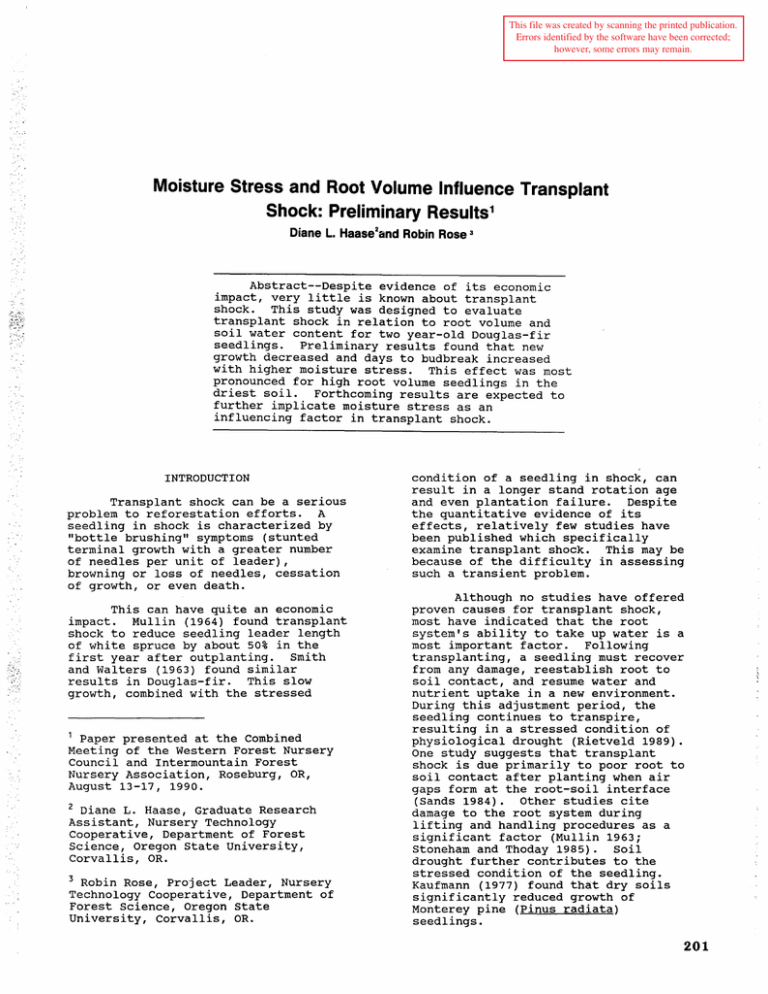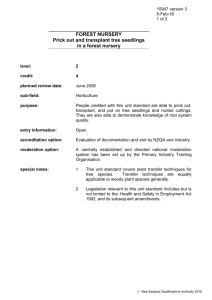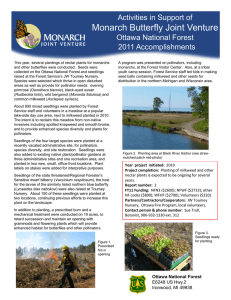Moisture Stress and Root Volume Influence... Shock: Preliminary Results
advertisement

This file was created by scanning the printed publication.
Errors identified by the software have been corrected;
however, some errors may remain.
Moisture Stress and Root Volume Influence Transplant
Shock: Preliminary Results 1
2
Diane L. Haase and Robin Rose 3
Abstract--Despite evidence of its economic
impact, very little is known about transplant
shock. This study was designed to evaluate
transplant shock in relation to root volume and
soil water content for two year-old Douglas-fir
seedlings.
Preliminary results found that new
growth decreased and days to budbreak increased
with higher moisture stress. This effect was most
pronounced for high root volume seedlings in the
driest soil.
Forthcoming results are expected to
further implicate moisture stress as an
influencing factor in transplant shock.
INTRODUCTION
Transplant shock can be a serious
problem to reforestation efforts. A
seedling in shock is characterized by
"bottle brushing" symptoms (stunted
terminal growth with a greater number
of needles per unit of leader),
browning or loss of needles, cessation
of growth, or even death.
This can have quite an economic
impact. Mullin (1964) found transplant
shock to reduce seedling leader length
of white spruce by about 50% in the
first year after outplanting. Smith
and Walters (1963) found similar
results in Douglas-fir. This slow
growth, combined with the stressed
1 Paper presented at the Combined
Meeting of the Western Forest Nursery
Council and Intermountain Forest
Nursery Association, Roseburg, OR,
August 13-17, 1990.
2
Diane L. Haase, Graduate Research
Assistant, Nursery Technology
Cooperative, Department of Forest
Science, Oregon State University,
Corvallis, OR.
3
Robin Rose, Project Leader, Nursery
Technology Cooperative, Department of
Forest Science, Oregon State
University, Corvallis, OR.
condition of a seedling in shock, can
result in a longer stand rotation age
and even plantation failure.
Despite
the quantitative evidence of its
effects, relatively few studies have
been published which specifically
examine transplant shock. This may be
because of the difficulty in assessing
such a transient problem.
Although no studies have offered
proven causes for transplant shock,
most have indicated that the root
system's ability to take up water is a
most important factor.
Following
transplanting, a seedling must recover
from any damage, reestablish root to
soil contact, and resume water and
nutrient uptake in a new environment.
During this adjustment period, the
seedling continues to transpire,
resulting in a stressed condition of
physiological drought (Rietveld 1989).
One study suggests that transplant
shock is due primarily to poor root to
soil contact after planting when air
gaps form at the root-soil interface
(Sands 1984). Other studies cite
damage to the root system during
lifting and handling procedures as a
significant factor (Mullin 1963;
Stoneham and Thoday 1985). Soil
drought further contributes to the
stressed condition of the seedling.
Kaufmann (1977) found that dry soils
significantly reduced growth of
Monterey pine (Pinus radiata)
seedlings.
201
Nursery cultural practices such
as fertilization, packing and
irrigation have also been examined as
possible factors in seedling field
performance (Darbyshire 1984; Jepson
and Paul 1984; Mellor et al. 1970).
However, even seedlings grown under
optimum cultural practices commonly go
into shock.
A few experiments have been done
to attempt to increase drought
resistance in planted seedlings by preconditioning (Kaushal and Aussenac
1989; Unterscheutz 1974). Although
these studies found that drought preconditioned seedlings had lower
transpiration rates, transplanted
seedlings still had reduced terminal
shoot growth. other studies have
indicated that cold storage may reduce
transplant shock. Jenkinson and Nelson
(1984)
found that survival potential,
growth capacity, and field performance
of seedlings stressed after storage
approximated that of unstressed
seedlings. Blake (1983) found that
cold stored seedlings appear better
able to avoid transplant shock and
early drought despite delayed root
growth.
It is unlikely that transplant
shock can be entirely eliminated.
However, it would be useful to target
specific seedling characteristics which
are correlated with minimum transplant
shock symptoms. These targeted
characteristics could be used to
supplement current seedling grading
criteria. Burdettt (1983) and sutton
{1979) both emphasize the importance of
a quality grading system which ensures
that stock is best adapted to the
planting site.
PROCEDURES
Plant material
Two year-old (2+0) Douglas-fir
seedlings from a BLM northwestern
Oregon provenance (seedlot 261-20-01,
Western Forest Tree Seed council, State
of Oregon Tree Seed Zone) were grown
under standard nursery cultural
practices at International Paper's
Kellogg Nursery located in western
Oregon approximately 10 km south of
Elkton. A live tree count before
lifting, on January 18, 1990, gave a
count of 25 seedlings per square foot.
Following lifting, seedlings were
graded to operational specifications.
Each tree was measured for height (em)
from bud scar to base of terminal bud,
caliper (mm) just below the bud scar,
root volume (cm3 ) measured by water
displacement, and total fresh weight
(g) •
Treatments
Following measurement, seedlings
were divided into four root volume
categories (table 1). These categories
were determined from the root volume
distribution shown in figure 1. Each
seedling was then randomly assigned to
a moisture stress treatment (table 2)
and experimental block.
Root Volume Distribution
2+0 Douglas-fir Transplant Shock Study
# of seedlings
70~----~------------------------------,
The objective of our current
research is to induce transplant shock
in 2+0 Douglas-fir (Pseudotsuga
menziesii [Mirb.] Franco.) seedlings by
applying moisture stress treatments in
a controlled greenhouse environment.
The data will be used to better
understand the causes of transplant
shock and to establish relationships
among initial seedling morphological
parameters, (specifically root volume),
moisture stress, and transplant shock.
These relationships could be applied to
nursery grading standards in order to
select seedlings which are least likely
to go into transplant shock following
transplanting to a specific site. This
paper is a report of our preliminary
results and future plans.
202
60
50
40
30
20
2
4
6
8
10
12
14
16
18
20
22
24
26
28
ROOT VOLUME (cc)
Figure 1.--Root volume distribution of
2+0 Douglas-fir seedlings in
transplant shock study.
Table 1.--The four root volume
categories used in this transplant
shock study.
CATEGORY
ROOT VOLUME CCC)
TW
we
1
5-8
DS
2
9-10
P
3
11-13
4
14-20
WATER
CONTENT (%}
Total weight (soil + water +
pot)
Water content of desired
treatment.
Average weight of dry soil in
each pot
Weight of pot
(Weight of seedlings was
considered negligible)
Table 2.--Moisture stress treatments
applied to seedlings in terms of
soil water content (%) and soil
water potential (MPa).
TREATMENT
where
WATER
POTENTIAL (MPa}
Pots were weighed two to three
times per week to assess water content
and were rewatered once they had dried
down to their specified water content.
sixty days after transplanting, new
terminal length (em) and lateral length
were measured. Days to terminal and
lateral budbreak were also monitored.
1
6
-1.60
PRELIMINARY RESULTS AND DISCUSSION
2
12
-0.80
Growth
3
18
-0.10
4
24
-0.01
New terminal and lateral length
depended on soil moisture content (fig.
2). Under more moist conditions (1824% water content), terminal length
stayed relatively constant over all
root volume categories. On the other
hand, with the drier soils (6-12% water
content), leader length tended to
decline as root volume increased. The
effect was most pronounced for the
driest soil treatment where seedlings
had the greatest reduction in growth at
high root volume (fig. 3).
(Field capacity
42 %)
Seedlings were transplanted into
15 liter plastic pots (five seedlings
per pot). The same weight of
sterilized soil mix was put in each
pot. All pots were thoroughly watered
after planting and placed in a
controlled greenhouse environment.
Fans were used daily for 6 hours to
lower greenhouse humidity, encourage
normal seedling transpiration, and
better simulate a true transplant
environment.
Moisture stress treatments
consisted of watering all pots to field
capacity and letting them dry down to a
predetermined soil moisture content and
then rewatering to field capacity over
a period of 120 days. Moisture stress
treatments were selected based on
earlier trials and represent a wide
range of soil water potentials
(table 2).
Soil water content was monitored
by weighing the pots and using the
following equation:
TW
= (WC * DS) + DS + P
It was not surprising to find that
under well-irrigated treatments, root
volume had little effect on growth.
However, we hypothesized that the
highest root volume should have the
greatest growth in drier soils because
of higher root growth potential and
greater absorption capacity {Carlson
and Miller 1990). We found the exact
opposite.
This apparent inconsistency may be
explained by the fact that seedlings
with higher root volumes were observed
to have a greater number of branches.
Therefore, selecting for higher root
volume may also be selecting for higher
leaf area and hence greater surface
area for transpiration. Pots with
higher root volumes needed to be
watered more often indicating
relatively higher water uptake (roots)
and demand (leaves). We speculate that
demand exceeds uptake by a greater
margin in the higher root volume trees
resulting in reduced growth.
203
Average Terminal Length
(A)
60 days after planting
Average Lateral Length
(B)
length (em)
60 days after planting
length (em)
10
t:
8
soil
8
6
~···~:r·
6
4
4
12%
2
2
6%
0
0
2
3
ROOT VOLUME CATEGORY
4
6'11.
12'11.
18'11.
MOISTURE TREATMENT
Figure 2.--Growth of seedlings 60 days after
planting depended on soil water content: (A)
terminal length decreased with higher
moisture stress especially for high root
volume seedlings; (B) lateral length also
decreased with stress, however, there was no
root volume interaction.
(A)
(B)
Figure 3.--Photographic comparison of moisture
treatment effect on high root volume
seedlings (14-20 cm3 ):
(A) treatment 1 (6%
water content) exhibiting transplant shock
symptoms; (B) treatment 4 (24% water content)
showing no evidence of shock.
204
24'11.
Budbreak
Similar to the growth
measurements, days to terminal and
lateral budbreak depended on soil water
content (fig. 4). At relatively high
water content (18-24%), days to
budbreak was generally constant,
irrespective of root volume. However,
at the drier water content (6-12%),
days to budbreak tended to increase
with increasing root volume. Once
again, the effect was most pronounced
with the driest soil (6%), where days
to budbreak increased about 30% from
root volume category 1 (5-8 cm3 )
to category 4 (14-20 cm3 )
Average Days to Terminal Budbreak
by treatment/root volume
(A)
days since planting
75,-----~~~------------------------~
soil
water content
70
6%
65
60
55
~12%
18%
50
24%
45~----~-------L------~------L-----~
2
3
4
ROOT VOLUME CATEGORY
(B)
60
Average Days to Lateral Budbreak
by treatment/root volume
days since planting
soil
water content
56
6%
Delayed budbreak with increasing
water stress has been found in another
ongoing study with the Nursery
Technology cooperative (unpublished
data) and was expected in this study.
Seedlings with large root volumes were
expected to be most vigorous (i.e.
initiate rapid budburst). However,
this was not the case, especially in
the driest treatment. As with growth,
we speculate that the high root volume
seedlings may actually be under greater
transpirational stress, despite a high
capacity for water uptake.
FURTHER PLANS
Seedlings were harvested in late
May, 1990 and measured for transplant
shock symptoms such as new terminal and
lateral growth, needle length, needles
per centimeter on the terminal, and dry
weights. Although the data have not
been analyzed yet, it appears that both
root volume and moisture treatments are
significant influences on transplant
shock.
It is expected that moisture
stress will be further implicated as an
important causal factor of transplant
shock and that the relationship between
initial root volume and transplant
shock will be better defined.
This study is being repeated with
seedlings from the same seedlot which
were cold stored for 120 days following
lifting. Since this second study is
being conducted at a different time, it
cannot be statistically compared to the
study with unstored seedlings.
However, observational differences will
be noted.
It is expected that the
moisture stress or root volume effects
may differ between the two studies
since the stored seedlings flushed much
earlier in the experiment before soil
dried to treatment levels.
52
A complete report of these studies
will be prepared for publication in
1991.
2
3
4
ROOT VOLUME CATEGORY
Figure 4.--Average days to budbreak
increased with increasing moisture
stress, particularly for seedlings
in the high root volume category,
for both (A) terminal budbreak and
(B) lateral budbreak.
ACKNOWLEDGEMENTS
We wish to thank the Nursery
Technology Cooperative and Oregon state
University for their support of this
research, International Paper's Kellogg
nursery for supplying the f?eedlings for
the study, and Steve Omi and John
Gleason for their review of the paper.
205
LITERATURE CITED
Blake, T.J. 1983. Transplanting shock
in white spruce; effect of cold
storage and root pruning on water
relations and stomatal
conditioning. Physiol. Plant. 57:
210-216.
Kaushal, P. and G. Aussenac. 1989.
Transplanting shock in Corsican
pine and Cedar of Atlas seedlings:
internal water deficits, growth
and root regeneration. Forest
Ecology and Management. 27: 29-40
Burdett, A.N. 1983. Quality control in
the production of forest planting
stock. Forestry Chronicle. 59:
132-138.
Mellor, G.E., Keller, R.A., and E.B.
Tregunna. 1971. Studies of
moisture status and storage
conditions for spring-lifted,
mud-packed seedlings. Canadian
Journal of Forest Research.
1: 223-227.
Carlson, w.c. and D.E. Miller. 1990.
Target seedling root system size,
hydraulic conductivity and water
use during seedling establishment.
Paper presented at the Combined
Meeting of the Western Forest
Nursery Council and Intermountain
Forest Nursery Association,
Roseburg, OR, August 13-17, 1990.
Darbyshire, R.L. 1984. Impacts of
nursery processing on the survival
and growth of 2+0 Douglas-fir
seedlings. Pages 33-37 in
Proceedings: Combined Western
Forest Nursery Council and
Intermountain Nurseryman's
Association meeting. Coeur d'
Alene, ID, August 14-16. General
Technical Report INT-185. USDA
Forest Service, Intermountain
Research Station.
· , ·'
Mullin, R.E. 1963. Planting check in
spruce. Forestry Chronicle.
39: 252-259.
Mullin, R.E. 1964. Reduction in
growth of white spruce after
out-planting. Forestry Chronicle.
40: 488-493.
Rietveld, R.J. 1989. Transplanting
stress in bareroot conifer
seedlings: its development and
progression to establishment.
Northern Journal of Applied
Forestry. 6: 99-107.
Sands, R. 1984. Transplanting stress
in radiata pine. Aust. Forest
Research. 14: 67-72.
Jenkinson, J.L. and J.A. Nelson. 1984.
Cold storage increases resistance
to dehydration stress in Pacific
Douglas-fir. Pages 38-44 in
Proceedings: Combined Western
Forest Nursery Council and
Intermountain Nurseryman's
Association meeting. Coeur d'
Alene, ID, August 14-16. General
Technical Report INT-185. USDA
Forest Service, Intermountain
Research Station.
Smith, J .H .• G. and J. Walters. 1963.
Planting check (reduction in
height growth) of planted
Douglas-fir seedlings.
Univ. B.C., For. Fac. Res.
Note 42. 4 p.
Jepson, T.M. and J.L. Paul. 1984.
Influence of fall fertilization
and moisture stress on growth and
field performance of containergrown Douglas-fir seedlings.
Pages 14-19 in Proceedings:
Combined Western Forest Nursery
Council and Intermountain
Nurseryman's Association meeting.
Coeur d' Alene, ID, August 14-16.
General Technical Report INT-185.
USDA Forest Service, Intermountain
Research Station.
sutton, R.F. 1979. Planting stock
quality and grading. Forest
Ecology and Management.
2: 123-132.
Kaufmann, M.R. 1977. Soil temperature
and drought effects on growth of
Monterey pine. Forest Science.
23: 317-325.
206
Stoneham, J. and P. Thoday. 1985.
Some physiological stresses
associated with tree
transplanting. Scientific
Horticulture. 36: 83-91.
Unterscheutz, P., W.F. Ruetz, R.R.
Geppert and W.K. Ferrell. 1974.
The effect of age, preconditioning, and water stress
on the transpiration rates of
Douglas-fir (Pseudotsuga
menziesii) seedlings of several
ecotypes. Physiol. Plant.
32: 214-221.






